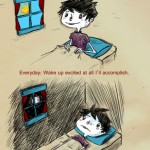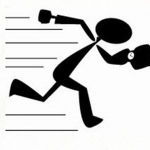Harness The Power Of Your Subconscious Mind
This rigid approach to writing would often cause me to remain frustrated at the keyboard for many hours at a time. I’d become even more frustrated at the end of the day, after noticing the amount of unproductive hours.
After experimenting with my writing method, I noticed how I’m able to create good writing more consistently when I don’t try to beat out an entire article in one sitting. As I fine-tuned my daily writing routine, I recognized the key difference: I started harnessing the power of my subconscious mind.
The ability to harness the power of your subconscious mind is likely to be beneficial to everyone, even if you’re not a writer. In this article, I will therefore be discussing my newfound method for taking advantage of my subconscious. Once you learn to do the same for yourself, you’ll enjoy putting this powerful asset to work for you while you’re doing other things.
For comparison’s sake, allow me to elaborate on my old writing method:
Step 1 – Select Article
I keep an always-growing list of “Article Ideas” within short reach of my writing area. This is because whenever I’m writing one article, I tend to stumble upon an idea that could be better explained in another article.
Instead of interrupting the creation process of the original article with thoughts of another article, I simply add the new article idea to the list and regain my original focus. Whenever I am in the mood to write, the first step involves selecting an article from the list of ideas. This way, I’m spared the stress of having to create new ideas on the spot whenever I want to write.
Step 2 – Create Headline
Creating a good headline is important, because a good article with a bad headline is worthless. The headline is the first thing a reader will see, and ultimately determines whether or not the article will be worth their time.
Step 3 – Develop Opening
Like the headline, the article opening is responsible for luring the reader into the article body.
Step 4 – Write Article Body
Every sentence within the body of the article should cause the reader to want to read the next sentence.
Step 5 – End Meaningfully
The end of each article should create a feeling of finalization — the strongest endings will tie in a reference to the article’s opening.
These five steps have long been my proven steps for consistently writing clear, concise, and meaningful blog posts. My new writing method does not do away with these steps — in fact, they’ve only been slightly adjusted.
Just how have the steps been adjusted? Let me remind you that using my old method, I was incredibly rigid. I would sit down to write, begin at Step 1 and beat the article into submission in a single sitting. It didn’t matter how long it took, I was determined to get it done no matter how much I struggled.
The problem in doing this, though, was the considerable time investment. I’d regularly breeze through the first two steps, then pause for a very long time before beginning the third. I’d select an article idea, create its headline, and then stare at my blinking cursor for what seemed like forever.
The more I tried to focus on the words I wanted to write, the more difficult it was to write anything at all. Before I knew it, I’d be checking my e-mail, chatting with my friends online, or reading other blogs. Once I noticed that I was procrastinating, I’d snap out of it only to face the same blinking cursor.
Call it writer’s block. Call it stupidity. Call it whatever you like, that article would sit unfinished for up to seven hours. There had to be a better way.
There is. My adjusted steps are as follows:
- Select Article
- Create Headline
- Shower
- Develop Opening
- Drive to the Library
- Write Article Body
- Drive Home
- End Meaningfully
It’s that simple. The italicized steps are periods of time I’ve sandwiched into my original 5 Step Writing Process. By creating these short breaks where I’m not staring my task in the face, I’m allowing my subconscious mind to take over before attempting the next step.
In other words, I’ve replaced the nonproductive action of staring at my blinking cursor with the productive-though-unrelated action of taking a shower. Insignificant as it may seem, the result has been consistent. After spending a few minutes selecting an article idea and creating its headline, I get into the shower and stop thinking about it.
Or at least, my conscious mind stops thinking about it. My subconscious mind, on the other hand, is piecing the article opening together with seemingly no effort. I’m focusing on washing behind my ears while my subconscious is struggling through the hard work on its own.
Suddenly, I know precisely how I intend to introduce the article. I turn off the water, dry myself off, throw on some clothes, then create the article’s opening with relative ease.
Similarly, after developing the article’s opening, I’ll begin my drive to my local library. During the short trip, I’ll suddenly realize a point I want to make in the article body. It never fails, my subconscious will be working overtime without my knowing it — my attention will be on the road, and before I reach my destination it will dawn on me that I know precisely what I intend to write next.
Having noticed a consistent pattern and being quite pleased with the results, I believe the method for harnessing the power of your subconscious mind to be a two step process:
- Spend a few minutes face-to-face with your intended task.
- Do an unrelated, ritualistic process requiring low concentration.
In my experiences, the ritualistic process needs to be something you’ve done so often that it can be accomplished without giving it your full attention. Showering, driving, washing dishes, and doing laundry are all straightforward, ritualistic, and somewhat mechanical processes that have caused me numerous “Ah-ha!” moments of enlightenment.
On the other hand, processes like reading, practicing piano, watching TV, and playing video games must require enough concentration to keep my subconscious dormant, because they have never triggered such moments.
What’s fascinating to me is the role of the first step. I imagine that during this initial period spent face-to-face with the task at hand, by acknowledging your desire to complete the task, you’re setting loose a horde of particles inside your brain. Once you’ve given them some momentum they roam around freely, bouncing off one another, resonating with other particles, working out which thought goes where.
Some time later, during the second step’s ritualistic process, you realize that the particles you’ve set loose have lined themselves up perfectly, and the answer seems plain as day.
No matter how slight these adjustments may seem, they have radically improved my productivity. If you find yourself regularly procrastinating, lacking creativity, or experiencing writer’s block, then I encourage you to harness the power of your subconscious mind.
Even if you already have a proven method for solving your own problems, remember that there’s always some room for improvement.
Related Posts
| If you've found this website helpful, please click the PayPal button. You will be helping me pursue my dream career as a writer. Thanks for your support! |













8 Responses to “Harness The Power Of Your Subconscious Mind”
Ive noticed this same process in songwriting. Too many times do we try to knock something out of the park in one sitting or take. I pretty much experience this daily. I am a Graphic Designer and though some projects are faster than others it seems sometimes that I try to finish a peice before I sink into boredom. Ive learned now to take a break and walk around the building and mess around a bit. As well in when I find myself at home and end up writing some music. I can’t tel you how many bits and peices of other unfinished songs I have lying around on scraps of paper….
I guess I never constructively noticed this process/meathod though, nice catch in the arts.
You’ve got to let the particles collide, man.
@Morris
I can see how this could definitely come into play in songwriting. I too have the tendency of scribbling ideas onto scraps of paper — in fact I’ve given serious thought about mounting a clipboard or something onto the dashboard of my car so that I can “catch” all of the ideas that come to me while driving. As always, thanks for commenting.
@story
As a fellow writer, so should you. 😀
This is what I enjoy about working at the library. After a few days to get used to the job it has become a “ritualistic process requiring low concentration” – especially stamping the date on the cards they stick in your books and whatnot when you check out. I could stamp cards (and daydream / brainstorm ideas for my own library) all day.
@Lauren
Did I read that right? Brainstorm ideas for your own library? Interesting thought — please tell me more about it!
i’ve had a lot of downtime at work lately, so the internet has become a good friend. usually i’m pretty good at bringing in homework/study things to get done between timepoints, but today i thought i’d click you some adds 🙂 as i was reading this, i was thinking about my day… and how the morning sucked, but i put off work during the afternoon and got a TON of errands done! and now i’m back at work in a much better mood, and probably far more “with it” since i gave myself time to eat and do non-science. sometimes a little procrastination is all you really need 🙂
Shouldn’t writing the introduction after the body and the conclusion are finished give a better introduction to the topic?